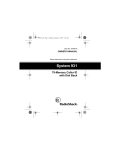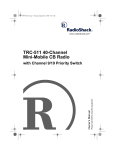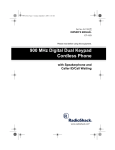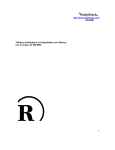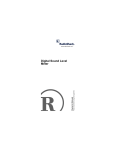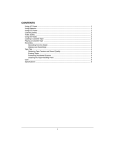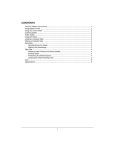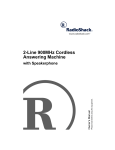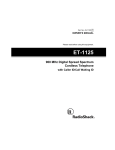Download Radio Shack Flat-Face Car CD Player Owner`s manual
Transcript
12-2158.fm Page 1 Wednesday, September 13, 2000 1:50 PM Flat-Face Car CD Player Please read before using this equipment. Owner’s Manual with Signal Level Meter Display 12-2158.fm Page 2 Wednesday, September 13, 2000 1:50 PM ˆ Contents Features .................................................................................................................................. 3 Installation .............................................................................................................................. 4 Preparing the Mounting Area ............................................................................................ 4 Routing Speaker Wires ..................................................................................................... 4 Removing the Shipping Screws ........................................................................................ 4 Making the Connections .................................................................................................... 5 Using an Adapter Harness ......................................................................................... 5 Connecting Ground, Power, and Optional Components ............................................ 5 Testing the Power Connections ................................................................................. 6 Connecting an Equalizer/Booster .............................................................................. 6 Connecting the Speakers .......................................................................................... 6 Completing the Connection ........................................................................................ 7 Testing the Connections ............................................................................................ 7 Mounting the CD Player .................................................................................................... 7 Removing the CD Player from the Dash .................................................................... 8 Mounting in Toyota, Nissan and Suzuki Vehicles ....................................................... 9 Installing/Removing the Control Panel ............................................................................ 10 Operation .............................................................................................................................. Setting the Clock ...................................................................................................... Adjusting the Sound ................................................................................................. Resetting the Display ............................................................................................... Radio Operation .............................................................................................................. CD Player Operation ....................................................................................................... Playing a CD ............................................................................................................ Selecting a Track ..................................................................................................... Audible Search ........................................................................................................ Scanning the Tracks ................................................................................................ Repeat Play ............................................................................................................. Random Play ........................................................................................................... 10 10 11 11 11 12 12 12 13 13 13 13 Troubleshooting ................................................................................................................... Care ................................................................................................................................ The FCC Wants You to Know ......................................................................................... CD Care Tips .................................................................................................................. Replacing a Fuse ............................................................................................................ 13 13 14 14 14 Specifications ....................................................................................................................... Radio ....................................................................................................................... CD Player ................................................................................................................ Signal Format .......................................................................................................... General .................................................................................................................... 15 15 15 15 16 © 2000 RadioShack Corporation. All Rights Reserved. RadioShack and RadioShack.com are trademarks used by RadioShack Corporation. 2 12-2158.fm Page 3 Wednesday, September 13, 2000 1:50 PM ˆ Features Your RadioShack Flat-Face Car CD Player has many practical, easy-to-use features, and you can install it in almost any vehicle using the supplied mounting bracket, hardware, and cables. Your CD player is easy to operate, so you can concentrate on driving safely. Your CD player’s features include: Detachable Flat-Face Front Panel — lets you quickly remove and store the CD player’s control panel in the supplied carry case. This discourages theft because the CD player cannot operate without the control panel. Audible Search — lets you rapidly play a CD forward or backward to locate a desired track or section of a track. Random Play — randomly selects and plays tracks. Repeat Play — automatically repeats the current track. Intro Scan — scans and plays the first 10 seconds of each track so you can find a specific track. Audio Mute — lets you silence the CD player by pressing a single button. Local/Distance Tuning Control — lets you set the radio to stop on only strong local stations or both local and weaker, distant stations. Bass, Treble, Fader, and Balance Controls — let you easily adjust the high and low sounds and the balance between the left/ right and front/rear speakers, so you can tailor the sound to your preferences. This CD player is made and tested to meet exacting safety standards. It meets FCC requirements and complies with safety performance standards of the U.S. Department of Health and Human Services. Loudness Button — lets you boost the volume of sounds at very high and low ranges, so you do not lose these sounds when the CD player's volume is set very low. Warnings: Line-Out Jacks — make it easy to connect an equalizer/amplifier. Built-In Noise Suppression Choke — reduces the noise caused by your vehicle's electrical system. • This system employs a laser light beam. Only a qualified service person should remove the cover or attempt to service this device, due to possible eye injury. • The use of controls, adjustments, or procedures other than those specified herein might result in hazardous radiation exposure. Liquid Crystal Display With Clock — shows the current operation of the CD and tuner with bar spectrum signal level display. Buzzer Alarm — alerts you when the speaker wires are connected in such a way that circuit damage could result. Features 3 12-2158.fm Page 4 Wednesday, September 13, 2000 1:50 PM ˆ Installation Before you install your CD player, read all the instructions in this owner’s manual. You should be able to answer all of these questions about your vehicle’s electrical and sound systems. • Which terminal in my vehicle’s fuse box supplies power even when the ignition is turned off? • Which terminal in my vehicle's fuse box is for accessories? • How do I connect a wire to the fuse box? • Which CD player wires are line-level outputs and which are speaker outputs? Also, be aware that installation in your vehicle might require cutting or modifying your vehicle. We recommend that you install the CD player by temporarily connecting it to ground and power, optional components, and your speakers. Then test the connections, disconnect the CD player, mount it in your vehicle, and reconnect it. The instructions in this manual are arranged in this order. • Be sure to avoid obstructions behind the mounting surface. Note: If the mounting area is too large, you might be able to mount the CD player with an in-dash installation kit, available at your local RadioShack store. Follow the installation kit’s instructions to mount the CD player. ROUTING SPEAKER WIRES If you install speakers, avoid routing the speaker wires near moving parts or sharp edges. You can usually route them along the wiring channel beneath the vehicle’s door facings by carefully removing the molding that holds the carpet in place. After you route the speaker wires, replace the molding. REMOVING THE SHIPPING SCREWS The shipping screws help protect the CD player from being damaged during shipment. Before you mount the CD player, use a Phillips screwdriver to remove the two screws from the top of the CD player. Shipping Screws PREPARING THE MOUNTING AREA Before you mount the CD player, be sure you have all the necessary materials. Then confirm that the CD player fits your vehicle’s mounting area. This auto sound CD player system is a DIN-E size unit that requires a 2124-inch high by 7124-inch wide by 71220inch deep (57 × 184 × 190 mm) mounting area. Cautions: • Make sure your vehicle’s mounting area is as level as possible. 4 Note: We suggest you tape the screws to the back of the CD player in case you ever want to mail or ship the CD player. Installation 12-2158.fm Page 5 Wednesday, September 13, 2000 1:50 PM MAKING THE CONNECTIONS the following procedure. Do not use a common wire or chassis ground for any speaker connection. The supplied harness with the 14-pin connector includes all the lead wires you need to connect the CD player to ground, power, optional components, and speakers. Important: Do not cut these wires. If you cut any wire, you cannot obtain a refund or exchange on this product. However, your RadioShack store will provide warranty service if you cut a wire and find the product is defective. You might need additional wire, depending on your individual auto sound system, to complete the connections. Your local RadioShack store carries a full line of wire and wire management accessories. Cautions: • For added safety and to protect your CD player, disconnect the cable from your vehicle battery’s negative (–) terminal before you begin. • Be sure your speakers can handle 50 watts of power (25 watts per channel if you are using one pair of speakers). Each speaker must have an impedance of at least 4 ohms. Your local RadioShack store carries a full line of speakers. • You must connect the GROUND (–), +12V TO IGNITION, and +12V TO BATTERY wires first, then make all other connections as described in the following sections before you plug the harness with the 14-pin connector into the CD player. If you do not make connections in the order shown, damage to the CD player is possible if any wire connections are made incorrectly. • You must connect a separate wire to each speaker terminal as described in The CD player’s buzzer alarm sounds if you make an incorrect connection that could damage the circuit. Using an Adapter Harness If you are replacing an existing CD player, or if your vehicle has been factory-wired for auto sound components, you might be able to use an adapter harness to connect the power and speakers. RadioShack sells adapter harnesses for most vehicles. Follow the directions that come with the adapter harness to temporarily connect the ground, power optional components and speakers. Then go to “Completing the Connection” on Page 7. Connecting Ground, Power, and Optional Components 1. Disconnect the cable from your vehicle’s negative (–) battery terminal. 2. Connect the black ground wire (with filter and fuse box) to a chassis ground, such as a metal screw attached to a metal part of the vehicle’s frame. Be sure that the screw is not insulated from the chassis by a plastic part. 3. Connect the red power wire (with in-line fuse holder) to a point in your vehicle’s fuse block that has power only when you turn the vehicle’s key to either the accessory (ACC) or the START position. This prevents your vehicle’s battery from being drained if you leave the CD player on when you turn off the ignition. 4. Connect the yellow power/memory wire (with filter and fuse box) to your vehicle battery’s positive (+) terminal or to a Installation 5 12-2158.fm Page 6 Wednesday, September 13, 2000 1:50 PM point in your vehicle’s fuse block that provides a continuous source of 12 volts. This provides power for the CD player’s components, and continuous power for the CD player’s memory when the ignition is turned off. 5. Connect the blue/white wire to any optional equipment designed to run from a switched source that you want the CD player to turn on and off (such as a booster or a power antenna). To use this wire you must first remove the insulation and strip the wire. This wire does not provide power to the components. If you do not use this wire, secure it with a wire tie and do not let it touch metal. Connecting an Equalizer/Booster If you are connecting the CD player to a separate equalizer or booster, you need additional wires (not included). To increase the total power output from your system, connect an equalizer or booster to the R (right) and L (left) line output jacks on the back of the CD player (and the 14-pin connector’s blue/white wire if you want to use the CD player to turn the equalizer or booster on and off). Line Output Jacks Equalizer or Booster Testing the Power Connections Temporarily connect: Blue/White Wire • the harness to the CD player’s 14-pin wiring socket Check the equalizer/booster's owner's manual for directions. • your vehicle battery’s negative (–) cable Connecting the Speakers Turn on your vehicle’s ignition and install the CD player’s control panel. See “Installing/Removing the Control Panel” on page 10. Verify that the CD player works properly when the display lights. If the display does not light, immediately turn off your vehicle’s ignition and disconnect your vehicle battery’s negative. (–) cable. Then recheck your connections. If the CD player works properly, remove the CD player’s control panel and disconnect: • your vehicle battery’s negative (–) cable • the harness from the CD player’s 14-pin wiring socket To connect the harness to two pairs of speakers: 1. Connect the white wire to the left front speaker’s positive terminal. This terminal is usually marked with a plus (+) sign or red mark. 2. Connect the white/black wire to the left front speaker’s negative terminal. This terminal might be marked with a minus (–) sign or it might not be marked at all. 3. Connect the gray wire to the right front speaker’s positive terminal. 4. Connect the gray/black wire to the right front speaker’s negative terminal. Then proceed with the installation. 6 Installation 12-2158.fm Page 7 Wednesday, September 13, 2000 1:50 PM 5. Connect the green wire to the left rear speaker’s positive terminal. when you play the radio (see “Radio Operation” on Page 11). 6. Connect the green/black wire to the left rear speaker’s negative terminal. If the display does not light and you do not hear a station, immediately turn off your vehicle’s ignition and disconnect your vehicle battery’s negative (–) cable. Then recheck your connections. 7. Connect the violet wire to the right rear speaker’s positive terminal. 8. Connect the violet/black wire to the right rear speaker’s negative terminal. To connect the harness to one pair of speakers: 1. Connect the gray wire to the right speaker’s positive terminal. 2. Connect the violet/black wire to the right speaker’s negative terminal. 3. Connect the white wire to the left speaker’s positive terminal. 4. Connect the green/black wire to the left speaker’s negative terminal. Completing the Connection Connect the vehicle’s antenna cable to the CD player’s antenna connector at the back of the unit. Make sure you have securely made all the connections described in the preceding sections, then plug the harness connector into the CD player’s 14-pin wiring socket. Reconnect the cable to the vehicle's negative (–) battery terminal. After you verify that the display lights and you hear a station, follow the instructions in “Mounting the CD Player.” Caution: If you played a CD while testing the connections, be sure to remove the CD from the CD Player before continuing. MOUNTING THE CD PLAYER Be sure you verify that the CD player is connected properly (see “Testing the Connections” on Page 7) before mounting in the dash. 1. Make sure the ignition is turned off, then disconnect the cable from the vehicle’s negative (–) battery terminal. 2. Disconnect the 14-wire harness and disconnect the antenna. 3. Press REL on the upper right corner of the control panel to remove the control panel. Testing the Connections Reset your CD player’s display (see “Resetting the Display” on Page 11), then install your CD player’s control panel (see “Installing/Removing the Control Panel” on Page 10). The display should light, and you should hear a station through the speakers Installation REL 7 12-2158.fm Page 8 Wednesday, September 13, 2000 1:50 PM 4. Take off the plastic trim ring by lifting the top of the trim ring. 9. To further secure the CD player, use the supplied hardware to attach one end of the supplied metal strap to the mounting bolt on the back of the CD player. If necessary, bend the metal strap to fit your vehicle’s mounting area. Then use the supplied sheet metal screw to attach the other end of the strap to a solid metal part of the vehicle under the dashboard. This strap also helps ensure proper electrical grounding of the CD player. Metal Strap 5. Insert the supplied keys into the slots on both sides of the CD player. Push them all the way in, then slide the CD player out of the sleeve. Washers Keys 6. Insert the sleeve into the dash. Then secure it by bending out all the tabs with a flat-blade screwdriver. 10. Reconnect the cable to the vehicle’s negative (–) battery terminal. Then replace the trim ring and install the CD player’s control panel (see “Installing/ Removing the Control Panel” on Page 10). You might need to reset the CD player’s clock after you reconnect the cable to the vehicle battery. (See “Setting the Clock” on Page 10.) Removing the CD Player from the Dash 1. Make sure the ignition is turned off and disconnect the cable from the vehicle’s negative (–) battery terminal. 8 7. Reconnect the harness to the CD player’s 14-pin wiring socket, then reconnect the antenna. 2. If the metal strap is used, remove the nut holding it to the back of the CD player. 8. Slide the CD player into the sleeve until it locks in place. 3. Press REL to remove the CD player’s control panel. Installation 12-2158.fm Page 9 Wednesday, September 13, 2000 1:50 PM 4. Remove the plastic trim ring by lifting the top of the trim ring. 7. Disconnect the 14-wire harness and the antenna. 5. Insert the supplied keys into the slots at both sides of the CD player, and slide the CD player out of the dash. 8. If you are mailing or shipping the CD player, reinstall the shipping screws in the top of the CD player. 6. Remove the keys from the slots. 9. Reconnect the cable to the vehicle’s negative (–) battery terminal. Mounting in Toyota, Nissan and Suzuki Vehicles If your vehicle is a Nissan, Toyota, or Suzuki, follow these mounting instructions or contact your nearest Toyota, Nissan or Suzuki dealer for installation information. Use the screw holes marked T (Toyota), N (Nissan) or S (Suzuki), located on both sides of the CD player to fasten the CD player to the factory radio mounting brackets supplied with your vehicle. Side view showing Screw Holes marked T, N, or S Vehicle Mounting Brackets and Screws Vehicle Mounting Brackets and Screws Hook and Screws 1. Use a Phillips screwdriver to loosen and remove the hook’s screws on the front left and right side of the CD player. Note: The mounting box, outer trim ring, and sleeve are not needed for this type of installation. 2. Align the screw holes on the bracket with the screw holes on the CD player, then tighten the screws on each side. Screw Selection Guide 3. Fasten with the supplied truss screws (5 × 5 mm) or flush surface screws (4 × 5 mm), depending on the shape of the screw holes in the bracket. Screw Type Quantity Car Type M 5 × 5 mm 4 T (Toyota), N (Nissan) M 4 × 5 mm 4 S (Suzuki) Installation 9 12-2158.fm Page 10 Wednesday, September 13, 2000 1:50 PM INSTALLING/REMOVING THE CONTROL PANEL sure the pins in the recess fill the slots in the edge of the control panel. CD Player Control Panel The CD player's control panel must be in place for the CD player to operate. When you remove it, the display turns off and the CD player cannot be used. This is a simple but effective security measure. Any stored stations remain in memory when the control panel is removed. Follow these steps to install the control panel: 1. Insert the left edge of the control panel into the left edge of the recess. Make 2. Gently push the right edge of the control panel into the recess until you hear a click. To remove the control panel, press REL. The control panel swings out. Remove it and store it in the supplied carry case. Caution: To keep the metal connecting pins clean, do not touch the connecting pins in the recess or on the back of the control panel. ˆ Operation TRACK + VOL + EJ REL TUNE SEL VOL – PWR MODE TRACK – MUTE (Play) LOC / RPT LOUD / RND DSP BND M/S / INT Caution: Do not change your CD player’s settings in heavy traffic or during hazardous driving conditions. repeatedly press VOL + until the correct hour displays then repeatedly press VOL – until the correct minute displays. To turn on the CD player, press PWR. The buttons and display light. To turn off the CD player, press PWR again. Note: The PM indicator appears at 12 noon and disappears at 12 midnight. Setting the Clock 1. Press PWR. Hold down DSP for about 2 seconds until the display flashes, then 10 Press DSP while the radio or a CD is playing to display the clock. To return to the display, press DSP or BND (while the radio is playing) or MODE to choose radio or CD mode. The CD player also automatically returns to the Operation 12-2158.fm Page 11 Wednesday, September 13, 2000 1:50 PM display after about 5 seconds if you do not press any buttons. Resetting the Display Adjusting the Sound 1. Press VOL + or VOL – to adjust the volume or repeatedly press SEL until VOL appears on the display. Then adjust the volume by pressing VOL + or VOL –. Warning: To protect your hearing, do not listen at high volume levels. Slowly increase the volume to a comfortable listening level. Note: The player is initially set to volume mode. RESET Use a ballpoint pen to press RESET at the top left side of the inside panel: • during initial installation, once all wiring is completed 2. Repeatedly press SEL until BAS appears, then press VOL + or VOL – to adjust the bass level. 3. Repeatedly press SEL until TRE appears, then press VOL + or VOL – to adjust the treble level. 4. Repeatedly press SEL until BAL appears, then press VOL + or VOL – to adjust the left/right sound balance. BAl (balance left) or BAr (balance right) appears. 5. Repeatedly press SEL until FAd appears. Then press VOL + or VOL – to adjust the sound balance between the front and rear speakers. FAF (fade front) or FaR (fade rear) appears. • if the stereo’s controls do not operate • if an error symbol (ER-1 through ER-8) appears on the display RADIO OPERATION 1. Press PWR. The radio automatically tunes to the last station and band selected. 2. Press BND to select the desired band, either FM (FM appears) or AM (AM appears). 3. Rotate TUNE to adjust the frequency. Notes: 6. To increase bass output, press LOUD. LOUD appears. To return bass output to normal, press LOUD again and LOUD disappears. To temporarily silence the CD player, press MUTE. MUTE appears. To resume listening, press MUTE again and MUTE disappears. Operation • In FM mode, the tuner stops on both strong and weak stations. To limit seek tuning to only strong stations, press LOC until LOC appears. • To improve reception of weak FM stations, press M/S until ST disappears. The sound is no longer in stereo, but the reception should improve. To return to stereo sound, press M/S again and ST 11 12-2158.fm Page 12 Wednesday, September 13, 2000 1:50 PM appears. If you get a steady FM signal, appears to the right side of ST. CdP (CD play), then TRACK 01, and Adjust the CD player’s controls to your listening preference (see “Adjusting the Sound” on Page 11). • If a CD is already in the CD player, simply press MODE to play the CD. The CD player displays the number of the last track you played, and the CD starts to play from that track. the CD plays from Track 1. CD PLAYER OPERATION • After the CD player plays the entire CD, it automatically repeats all tracks, starting with Track 1. Cautions: • Play only CDs that have this mark on them: • The CD player has a wide dynamic range. As a result, if you turn your CD player’s volume up too high during lowvolume sections of a program, your speakers might be damaged when a sudden loud passage occurs. • If the CD player is jolted during play, the rotation speed might suddenly change or the CD player might make an unusual noise. This is not a malfunction. • Driving on bumpy roads may cause the CD player to skip. Performance will improve after a short break-in period. Skipping does not damage CDs. Note: If you turn off your vehicle’s ignition or the CD player when a CD is loaded, you must wait about 5 seconds after turning the ignition back on before operation. 2. Repeatedly press VOL + or VOL – to increase or decrease the volume. Note: See “Adjusting the Sound” on Page 11 for information about changing the CD player’s other settings. 3. Press Press 4. • If you eject a CD while it is playing and do not remove it from the CD player, the CD player automatically draws the CD back in after about 5 seconds. • Do not expose the CD player to extremely high or low temperatures. Playing a CD 1. Insert a CD, label side up, into the slot. The radio stops. LOAdcd appears, then 12 To remove a CD from the CD player, press EJ. Notes: • Moisture and high humidity can cause malfunction of the CD player. Turn on the vehicle’s heater and allow moisture to evaporate before use. • Do not drive with an ejected CD in the slot. . to pause play. . flashes. . again to resume play. • If you eject a CD and remove it from the CD player, the CD player switches to radio operation. Selecting a Track To select a track on the loaded CD, press TRACK + during play to advance to the next track or TRACK – to go back to the beginning of the current track. Repeatedly press Operation 12-2158.fm Page 13 Wednesday, September 13, 2000 1:50 PM TRACK + or TRACK – to select the next or 2. Press INT again to resume normal play. previous track. Repeat Play Audible Search To search for a particular section within a track, hold down TRACK + or TRACK – during play. The CD player rapidly plays the CD either forward or backward, and the volume lowers. When you hear the section you want, release TRACK + or TRACK – to resume normal play. 1. To repeat a track, press RPT during play. When the track ends, it automatically repeats. 2. Press RPT again to resume normal play. Random Play You can set the CD player to randomly select and play tracks from the loaded CD. Scanning the Tracks You can set the CD player to play the first 10 seconds of each track on the loaded CD, so you can find the track you want to hear. 1. To begin scanning, press INT. 1. To begin random play, hold down RND for about 2 seconds until RND appears. 2. To stop random play, hold down RND for about 2 seconds until RND disappears. ˆ Troubleshooting If your CD player is not working properly, it displays an error indicator (ER-1 through ER-8). Press EJ to eject the CD and check it for scratches and condensation (see “CD Care Tips” on Page 14). Reload the CD and try again to play it, or try a different CD. If the CD player still does not operate properly, take it to your local RadioShack for assistance. CARE Your CD Player is an example of superior design and craftsmanship. The following suggestions will help you care for the CD player so you can enjoy it for years. • Keep the CD player dry. If it gets wet, wipe it dry immediately. Liquids can contain minerals that can corrode electronic circuits. • Use and store the CD player only in normal temperature environments. Temperature extremes can shorten the life of electronic devices and distort or melt plastic parts. • Keep the CD player away from dust and dirt, which can cause premature wear of parts. • Handle the CD player gently and carefully. Dropping it can damage the circuit boards and case and can cause it to work improperly. • Wipe the CD player with a damp cloth occasionally to keep it looking new. Do not use harsh chemicals, cleaning solvents, or strong detergents to clean the CD player. Modifying or tampering with the CD player’s internal parts can cause a malfunction and might invalidate your CD player’s warranty Troubleshooting 13 12-2158.fm Page 14 Wednesday, September 13, 2000 1:50 PM and void your FCC authorization to operate it. If your CD player is not performing as it should, take it to your local RadioShack for assistance. THE FCC WANTS YOU TO KNOW Your CD player might cause TV or radio interference even when it is operating properly. To determine whether your CD player is causing the interference, turn off your CD player. If the interference goes away, your CD player is causing it. Try to eliminate the interference by: • moving your CD player away from the receiver • contacting your local RadioShack store for help If you cannot eliminate the interference, the FCC requires that you stop using your CD player. CD CARE TIPS Even though a CD is very durable, you should handle it with care. We recommend the following precautions. • Keep the CD in its protective case or sleeve when you are not playing it. • Handle a CD by its edges to avoid fingerprints which can prevent the CD player’s laser beam from accurately reading the CD. Your local RadioShack store sells a suitable CD cleaner kit. • Do not write on either side of the CD, particularly the non-label side. (Signals are read from the non-label side.) • Keep the CD dry. A water drop can act as a lens and affect the laser beam’s focus. 14 • If you park your vehicle in the sun, temperatures inside the vehicle can easily reach levels that could damage your CDs. To prevent heat damage, avoid leaving your CDs in your vehicle. If a CD skips when you try to play it, it might be scratched. Your local RadioShack store sells a Scratch ’n’ Fix kit that might help remove the scratch and stop the skip. REPLACING A FUSE If the CD player does not operate, you might need to replace the red power wire’s 0.5A fuse with the supplied spare fuse. If the clock resets or stored stations are lost when the ignition is off, you might need to replace the black ground wire’s/yellow continuous power wire’s 5A fuse inside the filter and fuse box with the supplied spare fuse. Check both fuses. Note: A fuse’s amp rating is stamped on its metal end. Be sure to use the correct spare fuse to replace a failed fuse. 1. Disconnect the cable from the vehicle battery’s negative (–) terminal. 2. Unlatch the two latches on the red power wire’s fuse holder until it springs apart. 3. Pull up the latch on the filter and fuse box until the box springs open. 4. If either fuse is blown, replace it. Use only 11/4 × 1/4-inch fast-acting fuses with the proper rating. The red power wire’s fuse must be 0.5 amps, and the yellow continuous power wire’s fuse must be 5 amps. Caution: Make sure you replace a fuse only with another fuse of the same rating. Troubleshooting 12-2158.fm Page 15 Wednesday, September 13, 2000 1:50 PM 5. Reassemble the red power wire’s fuse holder by squeezing it together until it latches. 6. Reassemble the filter and fuse box by closing it then pushing the latch until it clicks. 7. Reconnect the cable to the vehicle battery’s negative (–) terminal. ˆ Specifications Radio FM (Nominal) AM (Nominal) Frequency Range 88–108 MHZ 530–1710 kHz Frequency Response (±3 dB) 50-12000 Hz N/A IF Rejection 100 dB 80 dB Image Rejection 55 dB 50 dB Selectivity 30 dB 30 dB Signal-to-Noise (S/N) Ratio 60 dB 45 dB CD Player Separation 30 dB N/A Usable Sensitivity 5.0 µV (3% THD) 32 µV (20 dB S/N) CD Player Frequency Response (–3 dB) .................................................................................................. 50-15000 Hz Signal-to-Noise Ratio .......................................................................................................................... 65 dB Harmonic Distortion [Ref] ...................................................................................................................... 0.3% CD Used (diameter) ........................................................................................................................... 5-inch (120 mm) Signal Format D-A Conversion ........................................................................................................................... 1Bit Linear Transmission Bit Rate .............................................................................................................. 1.4 Mbit/Sec Sampling Frequency ........................................................................................................................ 8 Times Pick-Up System ................................................................................................................... Optical Pick-Up Optical Source ..................................................................................................................................... Laser Number of Channels ............................................................................................................................ 4-Ch Specifications 15 12-2158.fm Page 16 Wednesday, September 13, 2000 1:50 PM General Power Source ....................................................................................................... 12V DC Negative Ground Speaker Output Impedance ..................................................................................................... 4 or 8 Ohms Maximum Power: One Pair of Speakers (Max Output) ......................................................................... 25 Watts RMS/Channel Power Output (10% THD @ 1kHz) .................................................................................. 16W × 2 or 5W ×4 Two Pairs of Speakers (Max Output) ......................................................................... 7 Watts RMS/Channel 1 Chassis Size (HWD) ............................................................................................... 2 /4 × 71/4 × 71/2 Inches (59 x 181 x 178 mm) Weight ................................................................................................................................................. 3.9 lb (1.76 kg) Specifications are typical; individual units might vary. Specifications are subject to change and improvement without notice. Limited One-Year Warranty This product is warranted by RadioShack against manufacturing defects in material and workmanship under normal use for one (1) year from the date of purchase from RadioShack company-owned stores and authorized RadioShack franchisees and dealers. EXCEPT AS PROVIDED HEREIN, RadioShack MAKES NO EXPRESS WARRANTIES AND ANY IMPLIED WARRANTIES, INCLUDING THOSE OF MERCHANTABILITY AND FITNESS FOR A PARTICULAR PURPOSE, ARE LIMITED IN DURATION TO THE DURATION OF THE WRITTEN LIMITED WARRANTIES CONTAINED HEREIN. EXCEPT AS PROVIDED HEREIN, RadioShack SHALL HAVE NO LIABILITY OR RESPONSIBILITY TO CUSTOMER OR ANY OTHER PERSON OR ENTITY WITH RESPECT TO ANY LIABILITY, LOSS OR DAMAGE CAUSED DIRECTLY OR INDIRECTLY BY USE OR PERFORMANCE OF THE PRODUCT OR ARISING OUT OF ANY BREACH OF THIS WARRANTY, INCLUDING, BUT NOT LIMITED TO, ANY DAMAGES RESULTING FROM INCONVENIENCE, LOSS OF TIME, DATA, PROPERTY, REVENUE, OR PROFIT OR ANY INDIRECT, SPECIAL, INCIDENTAL, OR CONSEQUENTIAL DAMAGES, EVEN IF RadioShack HAS BEEN ADVISED OF THE POSSIBILITY OF SUCH DAMAGES. Some states do not allow limitations on how long an implied warranty lasts or the exclusion or limitation of incidental or consequential damages, so the above limitations or exclusions may not apply to you. In the event of a product defect during the warranty period, take the product and the RadioShack sales receipt as proof of purchase date to any RadioShack store. RadioShack will, at its option, unless otherwise provided by law: (a) correct the defect by product repair without charge for parts and labor; (b) replace the product with one of the same or similar design; or (c) refund the purchase price. All replaced parts and products, and products on which a refund is made, become the property of RadioShack. New or reconditioned parts and products may be used in the performance of warranty service. Repaired or replaced parts and products are warranted for the remainder of the original warranty period. You will be charged for repair or replacement of the product made after the expiration of the warranty period. This warranty does not cover: (a) damage or failure caused by or attributable to acts of God, abuse, accident, misuse, improper or abnormal usage, failure to follow instructions, improper installation or maintenance, alteration, lightning or other incidence of excess voltage or current; (b) any repairs other than those provided by a RadioShack Authorized Service Facility; (c) consumables such as fuses or batteries; (d) cosmetic damage; (e) transportation, shipping or insurance costs; or (f) costs of product removal, installation, set-up service adjustment or reinstallation. This warranty gives you specific legal rights, and you may also have other rights which vary from state to state. RadioShack Customer Relations, 200 Taylor Street, 6th Floor, Fort Worth, TX 76102 We Service What We Sell RadioShack Corporation Fort Worth, Texas 76102 12/99 12-2158 09A00 Printed in China

















